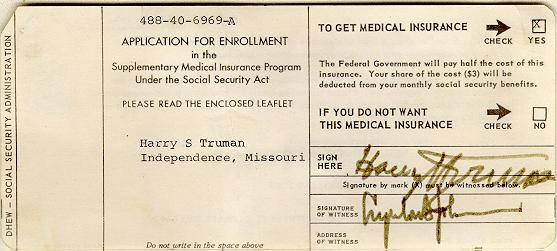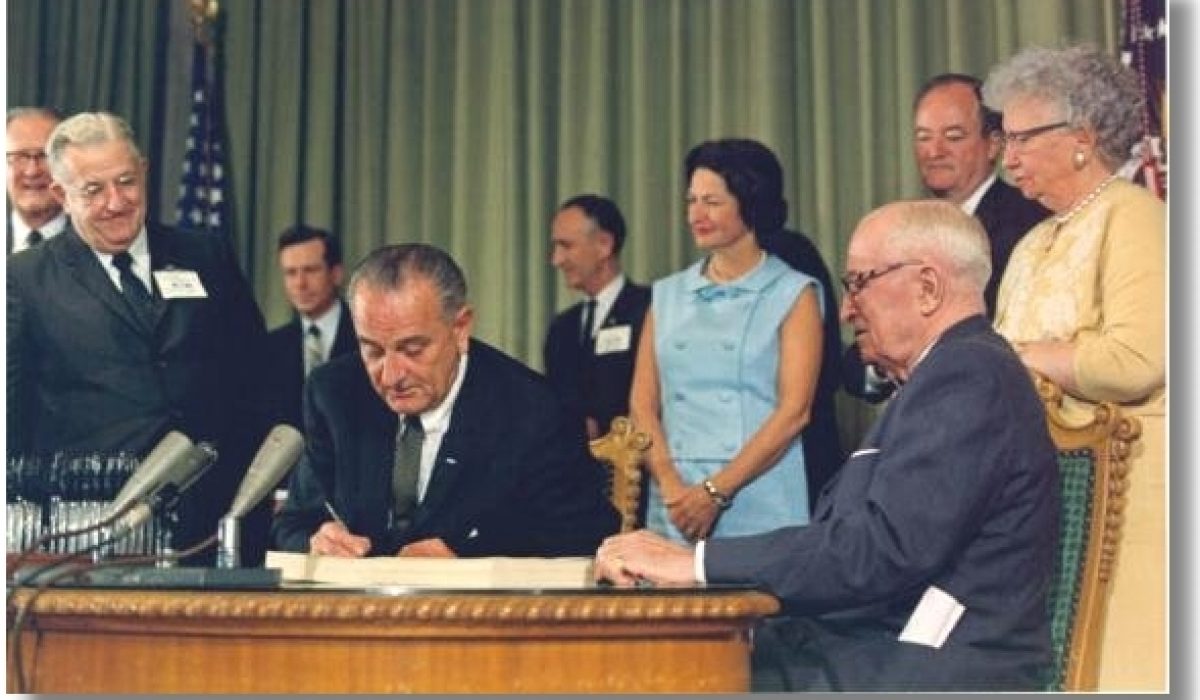Today marks the 59th anniversary of Medicare being signed into law.
This milestone offers an opportunity to reflect on Medicare’s history and the significant advancements in coverage that have occurred over nearly six decades.
From its inception to the present day, Medicare has evolved to meet the changing needs of America’s elderly and disabled populations.
Here’s a look at how far we’ve come.

This is President Truman’s application for the optional Part B medical care coverage, which President Johnson signed as a witness. SSA History Archives.
The History of Medicare
Medicare, the federal health insurance program for people aged 65 and older, and certain younger individuals with disabilities, was signed into law on July 30th, 1965, by President Lyndon B. Johnson.
Over the past 59 years, Medicare has undergone numerous changes and expansions to provide more comprehensive coverage to its beneficiaries.
This anniversary serves as a reminder of the program’s importance and the progress made in healthcare coverage for millions of Americans.
Medicare’s Inception and Initial Coverage
When Medicare was established in 1965, it was a groundbreaking move towards ensuring that older Americans had access to healthcare.
The program initially consisted of two parts:
- Part A (Hospital Insurance): Covered inpatient hospital stays, care in a skilled nursing facility, hospice care, and some home health care. Funded through payroll taxes, Part A provided essential hospital services to seniors.
- Part B (Medical Insurance): Covered doctor visits, outpatient care, preventive services, and medical supplies. Part B required a monthly premium and helped cover the cost of physician services and outpatient hospital care.
At its inception, Medicare’s coverage was revolutionary but limited compared to today’s standards.
It provided crucial hospital and medical services but lacked many of the benefits that beneficiaries have come to rely on in recent years.
Major Milestones in Medicare’s Evolution
Since 1965, Medicare has expanded significantly to include a wider array of services and benefits:
- 1972: Medicare was extended to cover individuals under 65 with long-term disabilities and End-Stage Renal Disease (ESRD), marking a significant expansion in eligibility.
- 1982: The introduction of hospice benefits allowed Medicare to cover end-of-life care, providing support for terminally ill patients and their families.
- 1997: The Balanced Budget Act introduced Medicare+Choice (now Medicare Advantage), allowing beneficiaries to choose health plans from private insurers that offered additional benefits.
- 2003: The Medicare Modernization Act established Medicare Part D, a prescription drug benefit program that provided coverage for outpatient prescription drugs, significantly reducing out-of-pocket costs for medications.
- 2010: The Affordable Care Act (ACA) made significant changes to Medicare, including closing the Part D “donut hole” coverage gap and providing free preventive services like annual wellness visits and screenings.
Major Differences in Medicare Coverage: Then vs. Now
Then: Limited Coverage and Out-of-Pocket Costs
In its early years, Medicare provided essential hospital and medical coverage but left beneficiaries with substantial out-of-pocket costs.
There was no coverage for prescription drugs, routine dental care, vision, or hearing services.
Long-term care was also not covered, leaving many seniors vulnerable to high medical expenses.
Now: Comprehensive Coverage and Preventive Services
Today, Medicare offers a much more comprehensive range of services:
- Part D (Prescription Drug Coverage): Introduced in 2006, Part D plans cover a wide range of prescription medications, helping reduce out-of-pocket costs for beneficiaries.
- Preventive Services: The ACA’s expansion of preventive services includes screenings for cancer, cardiovascular diseases, diabetes, and more, all without cost-sharing.
- Medicare Advantage (Part C): These plans offer additional benefits beyond Original Medicare, such as dental, vision, hearing, and wellness programs.
- Chronic Care Management: Programs have been introduced to manage chronic conditions more effectively, including care coordination and telehealth services.
- Home Health Care and Telemedicine: Medicare now covers a variety of home health services and telemedicine, providing more flexible and accessible care options for beneficiaries.
Speak with a licensed insurance agent!
Enter your Zip Code to View Medicare Plans in your Area
Impact on Beneficiaries
The expansion of Medicare coverage has led to improved health outcomes for millions of Americans.
Access to prescription drugs, preventive services, and comprehensive care has helped manage chronic conditions, detect diseases early, and reduce hospital admissions.
Beneficiaries now enjoy better overall health and quality of life.
Financial Protection
Medicare’s evolution has also provided greater financial protection for seniors and disabled individuals.
By covering more services and reducing out-of-pocket costs, Medicare helps protect beneficiaries from the financial burden of medical expenses.
Programs like Medicare Advantage and Medigap (Medicare Supplement) offer additional layers of financial security.
Future of Medicare
As Medicare celebrates its 59th anniversary, it faces ongoing challenges and potential reforms:
- Rising Healthcare Costs: Addressing the increasing cost of healthcare and ensuring Medicare’s long-term financial sustainability remains a priority.
- Innovative Care Models: Embracing new care models and technologies to improve efficiency and patient outcomes, such as expanded telehealth services and value-based care.
- Comprehensive Coverage: Advocating for the inclusion of more comprehensive benefits, such as long-term care and broader coverage for dental, vision, and hearing services.
Commitment to Improvement
Medicare’s history is one of continuous improvement and adaptation to meet the evolving needs of its beneficiaries.
Policymakers, healthcare providers, and advocates continue to work towards enhancing Medicare coverage, ensuring it remains a vital lifeline for future generations.
Conclusion
The 59th anniversary of Medicare is a testament to the program’s success in providing essential healthcare coverage to millions of Americans.
From its modest beginnings in 1965 to the comprehensive coverage it offers today, Medicare has made significant strides in improving health outcomes and financial security for seniors and disabled individuals.
As we look to the future, the ongoing commitment to improving and expanding Medicare ensures it will continue to meet the needs of its beneficiaries for years to come.
Medicare Parts
Speak with a licensed insurance agent!
Enter your Zip Code to View Medicare Plans in your Area
Speak with a licensed insurance agent!

